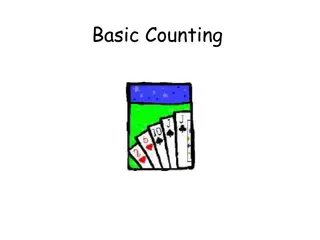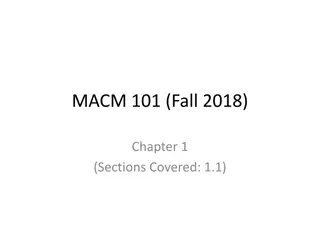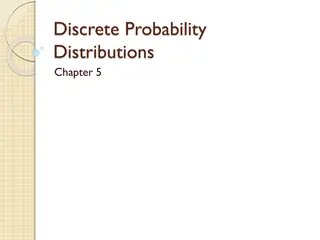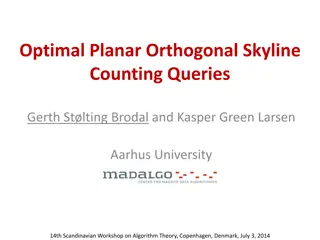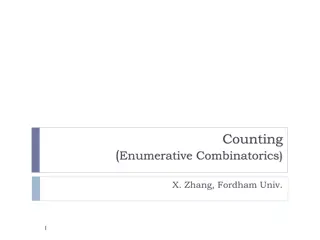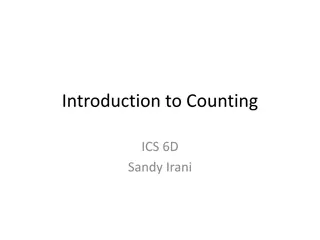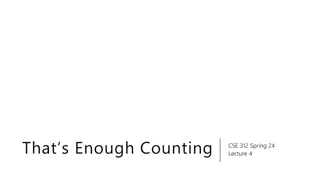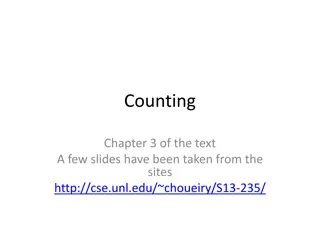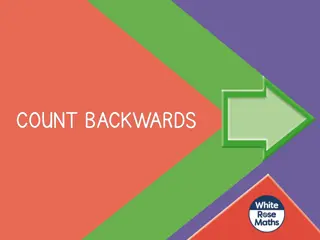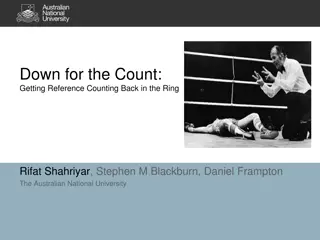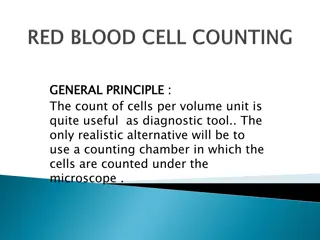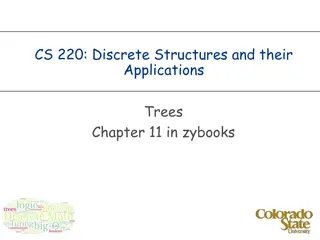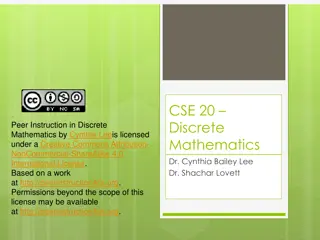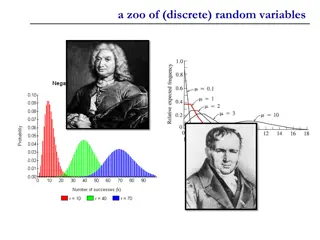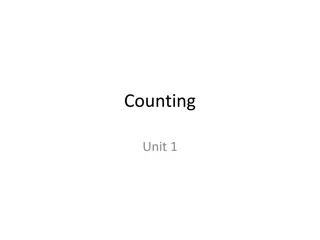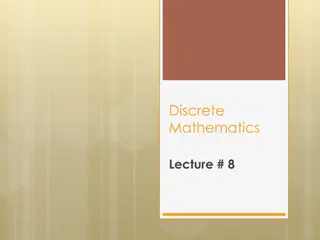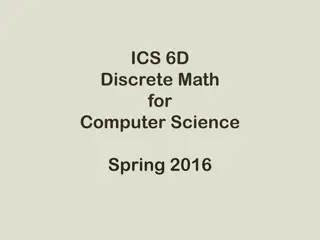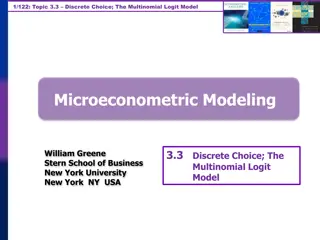Understanding Counting Principles in Discrete Structures
Counting serves a crucial role in algorithm design and complexity analysis, enabling us to determine program time and space complexities. This article explores counting principles such as the sum and product rules, Cartesian products, and their applications in solving simple and complex counting problems.
Download Presentation

Please find below an Image/Link to download the presentation.
The content on the website is provided AS IS for your information and personal use only. It may not be sold, licensed, or shared on other websites without obtaining consent from the author. Download presentation by click this link. If you encounter any issues during the download, it is possible that the publisher has removed the file from their server.
E N D
Presentation Transcript
CS 220: Discrete Structures and their Applications Counting: the sum and product rules zybooks 7.1 7.2 http://www.xkcd.com/936/
Why count Counting is an important aspect of algorithm design and complexity analysis. We need to count: the number of loop iterations to establish the time complexity of our programs, and the number of elements of our arrays / lists /dictionaries to establish the space complexity of our programs
A simple counting problem You have 6 pairs of pants and 10 shirts. How many different outfits does this give? Possible answers: 6 x 10 6 + 10 A) B)
enumerating outfits You have 6 pairs of pants and 10 shirts. How many different outfits does this give? We can express the set of all outfits as: {(s, p) | s shirts and p pants}
enumerating outfits You have 6 pairs of pants and 10 shirts. An outfit is a pair of pants AND a shirt. How many different outfits does this give? How would you write a program that prints out all the possible outfits? (Assume you have an array of shirts and an array of pants).
relation to Cartesian products The Cartesian product of sets A and B is denoted by A x B and is defined as: A x B = { (a,b) | a A and b B} The product rule is simply a statement about the cardinality of a Cartesian product: | A x B | = | A | * | B |
the product rule The general statement of the product rule: Let A1, A2,...,An be finite sets. Then, |A1 A2 An| = |A1| |A2| |An|
the product rule Example: counting strings Let is a set of characters (i.e. an alphabet); n is the set of all strings of length n whose characters come from the set . Applying the product rule: | n|=| |=| | | | | |=| |n Therefore, there are 2nbinary strings
the product rule Colorado assigns license plates numbers as three digits followed by three uppercase letters. How many license plate numbers are possible?
the product rule Colorado assigns license plates numbers as three digits followed by three uppercase letters. How many license plate numbers are possible? A) 310 x 326 2 x 310 x 326 103 x 263 B) C)
more examples How many bit strings of length 7 are there? A) 7 x 6B) 72 C) 27 How many functions are there from a set with m elements to a set with n elements?
another counting problem Suppose you order a drink, and you can select either a hot drink or a cold drink. The hot drink selections are {coffee, hot cocoa, tea}. The cold drink selections are {milk, orange juice}. What is the total number of choices? 3 + 2 3 x 2 3! x 2! A) B) C)
another counting problem Suppose you order a drink, and you can select either a hot drink or a cold drink. The hot drink selections are {coffee, hot cocoa, tea}. The cold drink selections are {milk, orange juice}. What is the total number of choices? 3 + 2 3 x 2 3! x 2! A) B) C) The difference from the product rule: there is a single choice to be made.
the sum rule The sum rule is also statement about set theory: If two sets A and B are disjoint then |A B| = |A| + |B| If A and B are not disjoint, then |A B| = ?
the sum rule The general form of the sum rule: Consider n sets, A1, A2,...,An. If the sets are mutually disjoint (Ai Aj = for i j), then |A1 A2 An| = |A1| + |A2| + + |An|
example A student can choose a computer project from one of three lists. The three lists contain 23, 15, and 4 possible projects. No project is on more than one list. How many possible projects are there to choose from?
example The product and sum rule can be combined: Suppose you need to pick a password that has length 6-8 characters, where each character is an uppercase letter or a digit. How many possible passwords are there? P = P6+P7+P8 Pk= 36k
example The product and sum rule can be combined: How many license plates can be made using either two or three uppercase letters followed by two or three digits? (262+263)*(102+103)
The generalized product rule Consider the following counting problem: In a race with 20 runners there is a first place, a second place and a third place trophy. An outcome of the race is defined to be who wins each of the three trophies, i.e. 3 distinct runners. How many outcomes are possible? 20*19*18 WHY?
The generalized product rule Choosing sequences of items Consider a set S of sequences of k items. Suppose there are: n1 choices for the first item. For every possible choice for the first item, there are n2 choices for the second item. For every possible choice for the first and second items, there are n3 choices for the third item. For every possible choice for the first k-1 items, there are nk choices for the kth item Then |S| = n1 n2 nk.
example A family of five (2 parents and 3 kids) goes on a hiking trip. The trail is narrow and they must walk single file. How many ways can they walk with a parent in the front and a parent in the rear?
example Consider the following definitions for sets of characters: Digits = { 0, 1, 2, 3, 4, 5, 6, 7, 8, 9 } Letters = { a, b, c, d, e, f, g, h, i, j, k, l, m, n, o, p, q, r, s, t, u, v, w, x, y, z } Special characters = { *, &, $, # } Compute the number of passwords that satisfy the following constraints: (a) Strings of length 6. Characters can be special characters, digits, or letters, with no repeated characters. (b) Strings of length 6. Characters can be special characters, digits, or letters, with no repeated characters. The first character cannot be a special character.
Making Change Goal. Given integer coin values, e.g.: {1,5,10,25} compute in how many ways you can pay a certain amount: Example: 29 . How many ways? 25, 1,1,1,1 10,10, 5, 1,1,1,1 10, 5,5, 5, 1,1,1,1 10, 5,5, 1,1,1,1,1, 1,1,1,1 . . . 1,1,1,1,1, 1,1,1,1,1, 1,1,1,1,1, 1,1,1,1,1, 1,1,1,1,1, 1,1,1,1
Making Change Given a coin set c = {c0, c1, ..., cn-1} and an amount M, how many different ways can M be paid? Recursive solution: given coin value cd , how many coins can I use ? e.g., for eg 56 cents I can use 0, 1, or 2 quarters Base: if d == 0, how many ways? (is there always a way ?) Step: if d>0, go through all possible uses of coin d at least how many cd coins can be used and which problem then remains to be solved? ... at most how many cd coins can be used and which problem then remains to be solved?
Making Change coins (29, 3) d=3: Quarters [1, 5, 10, 25] ^ 0 1 (29, 2) (4, 2) d=2: Dimes [1, 5, 10, 25] ^ 0 2 (9, 1) . . . 1 0 (29, 1) . . . d=1: Nickles [1, 5, 10, 25] ^ (19, 1) (4, 1) 0 3 2 1 0 (4, 0) (19, 0) (9, 0) (14, 0) (4, 0) d=0: Cents [1, 5, 10, 25] ^ # code structure mkCh( M, d): if coin-index d==0: # base case: does coin0 divide amount M else # for I from 0 to # coins[d] fitting in M sum results of mkCh(remaining amount, new coin-index)
Programming Assignment Write a (recursive) function mkCh() that counts the number ways a certain amount of money can be paid with a coin set {1,5,10,25}
k out of n partitions Given n distinct elements, we want to group these into k partitions. E.g. n=3 {b,c,d} How many 2 out of 3 partitions are there? Enumerate . . . {b} {c,d} {c} {b,d} {d} {b,c} there are 3 2-out-of-3 partitions
Counting the number of k-out-of-n partitions Now n=4 {a,b,c,d} How many 3-out-of-4 partitions are there? Typical Divide and Conquer (hence recursive) approach: take element a There are two possibilities: 1) either a is in its own partition or 2) not We can apply the sum rule 1) a is in its own partition, then there are 2 more partitions out of three elements {b,c,d}. We already solved how many 2 out of 3 partitions there are: {b} {c,d} {c} {b,d} {d} {b,c} So for this case we get 3 solutions {a} {b} {c,d} {a} {c} {b,d} {a} {d} {b,c}
Second possibility 2) a is not in its own partition, then is it in 1 of the 3 3-out-of-3 partitions: {b} {c} {d} so in case 2) we have 3 possibilities {a,b} {c} {d} {b} {a,c} {d} {b} {c} {a,d} So in total there are 6 3-out-of-4 partitions
Do it yourself How many 2-out-of-4 partitions are there?
Do it yourself How many 2-out-of-4 partitions are there? {a,b,c,d} Option 1: a on its own {a} {b,c,d} Option 2: a joins one of: {b} {c,d} {a,b} {c,d} {b} {a,c,d} {c} {b,d} {a,c} {b,d} {c} {a,b,d} {d} {b,c} {a,d} {b,c} {d} {a,b,c} So in total 7 (1 + 2*3) 2_out_of_4 groups
Program structure Recursive function partitions(n,k) # k partitions out of n elements Base: k == 1 (all n elements in one partition) k == n (each element in its own partition) Step: either a on its own: partitions(n-1,k-1) or not: then form k partitions out of n-1 . a can join each: k* partitions(n-1,k)
Programming Assignment Write a (recursive) function partitions(n,k) that counts the number of k-out-of-n partitions



